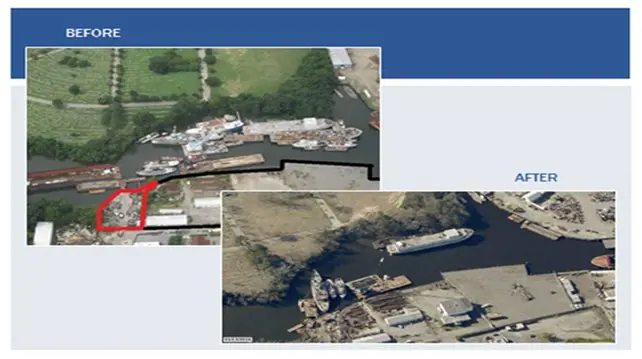Environmental Law Eliminates a Floating Junkyard (Part 2 of 2) - June 2016
By Jim Lang - June 2016
The Citizen's Environmental Lawsuit (Because Nothing Else Worked)
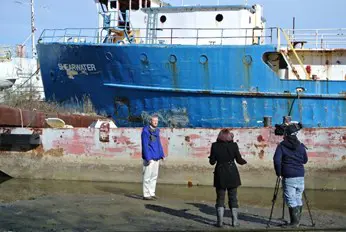
Mr. Landowner Decides to File a Citizen's Environmental Lawsuit
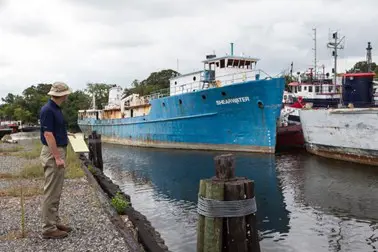
legally required disclaimer:
CASE RESULTS DEPEND UPON A VARIETY OF FACTORS UNIQUE TO EACH CASE. CASE RESULTS DO NOT GUARANTEE OR PREDICT A SIMILAR RESULT IN ANY FUTURE CASE UNDERTAKEN BY THE LAWYER.
end of legally required disclaimer
Clean Water Act: Grounded Vessels are a "Pollutant" Subject to the CWA
According to the Complaint a 200' hopper barge (shown immediately above) 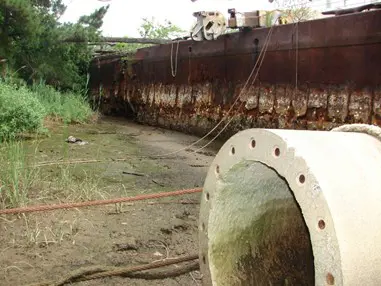 formerly was located in the water directly across the waterway from the 1-acre parcel that Mr. Collector purchased in 2005. The Complaint explained how, after Mr. Collector acquired the property next door to Mr. Landowner, Mr. Collector opportunistically used his tug to relocate the hopper barge a few hundred yards upriver and push it ashore into wetlands on the river bank directly opposite the property owned by Mr. Landowner. The hopper barge, according to the Complaint sat there, partly in the river and partly in the wetlands, for many years, while the wind and the weather took its toll on the vessel with rust causing massive breaches in the hull. During this time, according to the Complaint, Mr. Collector used the 10,000 square foot surface area at the top of the hopper barge as a platform on which to store his equipment and used the structure of the hopper barge as the "pier" to which he tied up many of the vessels in his Floating Junkyard.
formerly was located in the water directly across the waterway from the 1-acre parcel that Mr. Collector purchased in 2005. The Complaint explained how, after Mr. Collector acquired the property next door to Mr. Landowner, Mr. Collector opportunistically used his tug to relocate the hopper barge a few hundred yards upriver and push it ashore into wetlands on the river bank directly opposite the property owned by Mr. Landowner. The hopper barge, according to the Complaint sat there, partly in the river and partly in the wetlands, for many years, while the wind and the weather took its toll on the vessel with rust causing massive breaches in the hull. During this time, according to the Complaint, Mr. Collector used the 10,000 square foot surface area at the top of the hopper barge as a platform on which to store his equipment and used the structure of the hopper barge as the "pier" to which he tied up many of the vessels in his Floating Junkyard.
The CWA at 33 U.S.C. section 1311(a) prohibits discharge of a pollutant (from a point source) by any person into "the water of the United States" without a permit. "Fill" is a type of CWA pollutant. The regulations that implement the CWA (33 C.F.R. section 323.2(e)) explain that "fill" is something that changes the bottom elevation of the water. The hopper barge was changing the bottom elevation in the river, and in the wetlands adjoining the river, so Count VI in the Complaint (pages 31 to 33) asked the Court to force Mr. Collector to remove the hopper barge and to pay a suitable fine to the United States for his violation of the Clean Water Act.
According to the Complaint, Mr. Collector also had two other ships, larger than the hopper barge,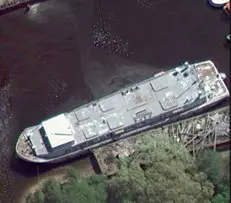 both aground on the river bottom 80% of the time (temporarily lifting off the river bottom only when the tides were at the highest level). One was a 262’ former U.S. Navy vessel, formerly known as the USS YRST-2. It is shown in the nearest photo (you can see in the photo that it is tied up at the hopper barge).
both aground on the river bottom 80% of the time (temporarily lifting off the river bottom only when the tides were at the highest level). One was a 262’ former U.S. Navy vessel, formerly known as the USS YRST-2. It is shown in the nearest photo (you can see in the photo that it is tied up at the hopper barge).
The other ship was a 245' former sugar barge, christened the ATC-12,000, which is the top-most vessel in the photo below.
The Complaint explained that Mr. Collector had left these two large ships aground at their present location for many years. Count VII (pages 34-35 of the Complaint) and Count VIII (pages 35-37 of the Complaint) brought CWA claims of a “fill” violation against Mr. Collector with respect to these two large ships. Mr. Landowner asked the Court in the Complaint to force Mr. Collector to remove both of these large ships and to pay a suitable fine to the United States for his violation of the Clean Water Act.
Mr. Collector’s response was to file a motion with the Court demanding that the Court dismiss the CWA claims brought by Mr. Landowner with respect to the three vessels that were aground. Mr. Collector did not deny that the vessels were aground but claimed in his Motion to Dismiss that a vessel can never be “fill”. Mr. Landowner wrote a Brief and filed it with the Court that explained the errors that Mr. Collector was making in his Motion to Dismiss. The Court held a hearing that allowed Mr. Collector and Mr. Landowner to make their arguments to the Court, after which the Court ruled in favor of Mr. Landowner. This link is to the Opinion and Order that was entered by the court.
Resource, Conservation and Recovery Act: The Hopper Barge is a Solid Waste Management Facility that Mr. Collector Operates in Violation of RCRA
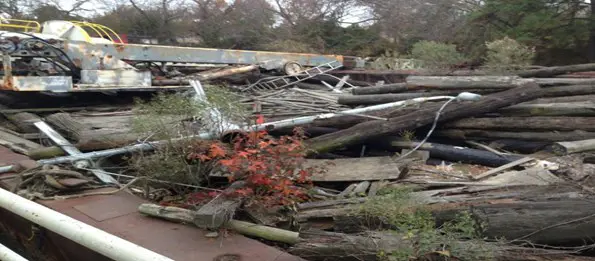
The Complaint at pages 25-26 explained how the inner cavity of the hopper barge was filled enough trash, rubbish and waste to fill 220 dump trucks (as shown in the photo immediately above). The details of RCRA are found at 42 USC §§6921 to 6991m. This law was enacted in 1976 as the nation’s primary law governing the treatment, storage and disposal of solid and hazardous waste. Mr. Collector, according to the Complaint, was storing 4,000 cubic yards of solid waste inside the hopper barge, on the banks of the Elizabeth River, with no RCRA permit. This meant that, according to the Complaint, Mr. Collector was violating RCRA. Mr. Landowner asked the Court at Counts IV and V in the Complaint (pages 25 to 30) to force Mr. Collector to come into compliance with RCRA and to pay a suitable fine to the United States for his violation of RCRA.
The photo below shows some of the other trash, rubbish and waste in the inner cavity of the hopper barge, as described in the Complaint:
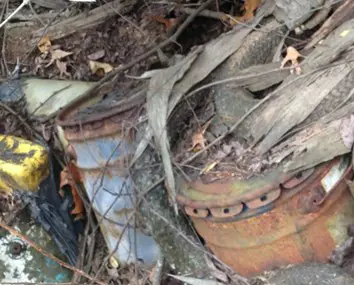
As was done with the CWA claims, Mr. Collector filed a Motion to Dismiss the RCRA claims, which forced Mr. Landowner to file a Brief Opposing the Motion to Dismiss, after which the Court held a hearing and then entered its Opinion and Order. The Court, in its Opinion and Order, directed Mr. Landowner to re-format the RCRA claims in Counts IV and V and then re-submit them to the Court in the form of an Amended Complaint. Once Mr. Landowner completed this task, the RCRA claims against Mr. Collector went forward in the Court, along with the CWA claims.
Mr. Collector Agrees to Clean Up the Floating Junkyard
As was recently reported by Andy Fox on WAVY 10 television, the citizen’s environmental lawsuit forced Mr. Collector to clean up the Floating Junkyard. Mr. Fox' reporting includes the most recent aerial photography currently available, made by "chopper 10" on May 31, 2016. It shows the near-complete removal of the Floating Junkyard, with only the hopper barge remaining in the waters that Mr. Collector is now forbidden to use. The Court has entered its Permanent Injunction on Consent, the terms of which require Mr. Collector permanently to keep his ships away from the waters in front of Mr. Landowner’s property. The Court, in its Permanent Injunction on Consent, has ordered Mr. Collector to remove the hopper barge from the waterway "on or before August 15, 2016".
Contact our waterfront law team with any questions.
